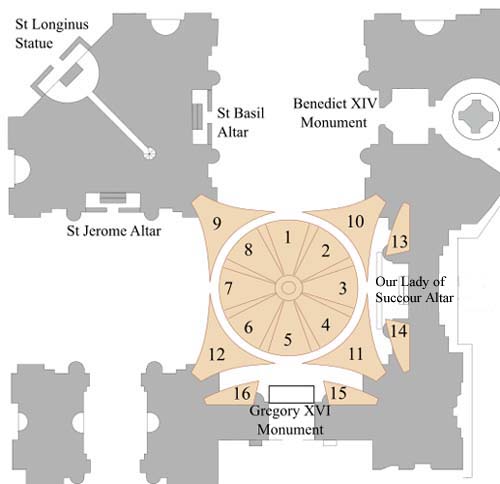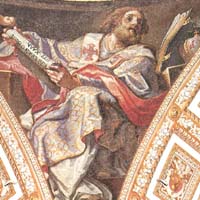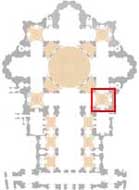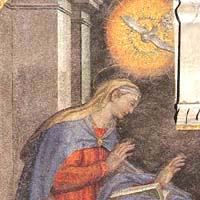

From the second half of the 1500s, St Peter's became the largest laboratory in Europe in the practice of mosaic art. For the decoration, men experienced in this craft were requested from Venice, which boasted an unbroken tradition from the Middle Ages thanks to the building site of St Mark. They knew the mosaic technique and its secrets very well, and therefore were necessary to be able to begin the construction. The work of decoration of the Gregorian Chapel begins on June 5, 1576 and ends May 30, 1579. Pope Gregory XIII wanted to create the first new chapel in St Peter's and decorate it with mosaics. The Gregorian Chapel, which has an extraordinary iconographic wealth, takes its name from him. In the lunettes, which sit above the altar, Pope Gregory XIII had wanted to represent the mystery of the Annunciation. On the left is the Virgin kneeling in a pose of meditative prayer, while the Holy Spirit comes to her. An angel on the right, descends from the clouds that act as a ladder. The message is completed by the presence of Isaiah and Ezekiel, the prophets who pronounced Mary's virginity. Where the dome rests on the square beneath, four spandrels display four Doctors of the Church: Gregory the Great, Jerome, Gregory of Nazianzus and Basil. Gregory the Great was particularly dear to Gregory XIII, as he took his name from him. The presence of the eastern Father, Gregory of Nazianzus, arose from the fact that the pope was devoted to the great bishop of Byzantium from the fourth century, and admired his Trinitarian doctrine. The pope had Gregory's relics moved from the Holy Monastery of St Mary in Campo Marzio, much to the chagrin of the Benedictine nuns. The image of St Basil was included because of his great friendship with Gregory of Nazianzus. Basil, who was bishop of Caesarea, is known along with Nazianzus as a Cappadocian Father. Jerome was the great Doctor of the virginity of Mary. In Rome (c.383), he wrote a passionate defense of this doctrine. With the image of Jerome, we also see the devotion of the artist, Girolamo Muziano, to whom we owe many representations of his patron saint. The four Doctors, with their large gestures and liturgical clothing, appear imposing. The only one dressed roughly as a penitent hermit is Jerome. These images hold the record as the first mosaics in the new Vatican basilica. Sources Simona Turriziani, St Peter in the Vatican, The Mosaics and Sacred Space (2011) Frank DiFrederico, The Mosaics of Saint Peter's (1983) Antonio Pinelli, The Basilica of Saint Peter in the Vatican (2000) |
|
|
Contact: stpetersbasilica@gmail.com
©
Copyright notice This independent website is not endorsed by or associated with the Vatican, the Fabbrica of St. Peter's, or any business organization |


